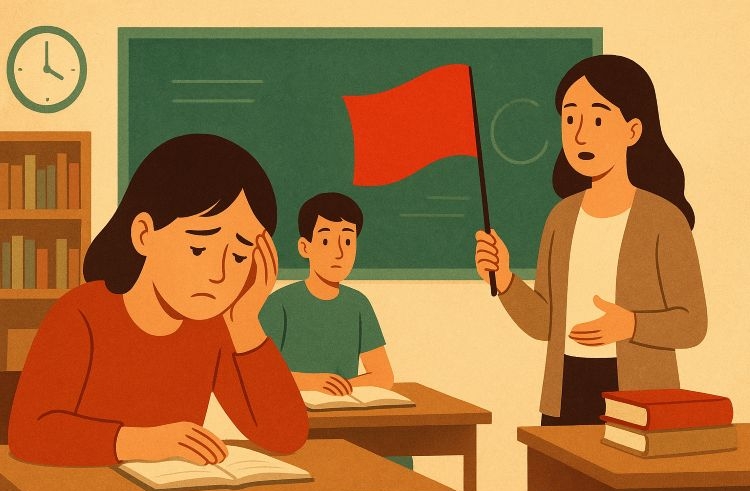
By Siddharth Rajgarhia
 We often believe that our role as educators begins with curriculum and ends with assessment. But beneath the lesson plans and gradebooks lies a more delicate, more profound truth: we are custodians of growing hearts navigating a world more complex than we ever faced. Each child walks into school not just with a backpack of books, but with an emotional weight they cannot always name. The real learning, then, is not just about mastering equations or essays—but about discovering inner balance in the midst of outer chaos. Mental health, once a whisper in the staff room, is now a central thread in the tapestry of modern education. And if we do not pay attention to it, we risk failing our children in ways far more damaging than a failed exam.
We often believe that our role as educators begins with curriculum and ends with assessment. But beneath the lesson plans and gradebooks lies a more delicate, more profound truth: we are custodians of growing hearts navigating a world more complex than we ever faced. Each child walks into school not just with a backpack of books, but with an emotional weight they cannot always name. The real learning, then, is not just about mastering equations or essays—but about discovering inner balance in the midst of outer chaos. Mental health, once a whisper in the staff room, is now a central thread in the tapestry of modern education. And if we do not pay attention to it, we risk failing our children in ways far more damaging than a failed exam.
Why the Concern is Real and Growing
Today’s students inhabit a landscape of silent pressures and invisible battles.
- Academic pressure has become a shadow that looms over every test and assignment.
- Digital overload bombards them with curated realities, fuelling anxiety and comparison.
- Family challenges ranging from financial stress to emotional distance, create insecurity.
- Post-pandemic trauma stays in their nervous systems, even as life seemingly “returns to normal.”
- The search for identity, compounded by societal expectations, can leave them adrift in self-doubt.
The result? A generation of students more connected than ever, and yet more emotionally isolated. And while these struggles are real, they rarely announce themselves. They whisper. They hide behind a smile, a joke, or a sudden silence. This is why your presence, as an educator, matters more than your pedagogy.
What Do the Red Flags Look Like?
Mental health issues don’t come with a label. But if you look closely, the signs are there gentle ripples, beneath the surface of a child’s behaviour.
- Social Withdrawal: Once talkative students who now choose solitude over interaction.
- Declining Academic Performance: Missed deadlines, unfinished work, a visible drop in engagement.
- Frequent Absences: Repeated unexplained absences or late arrivals.
- Mood Fluctuations: Unusual irritability, prolonged sadness, or emotional outbursts.
- Neglected Appearance: A sharp change in grooming, dressing, or body language.
- Physical Symptoms: Frequent, vague complaints like headaches or stomach aches.
- Risky Behaviour: Defiance, self-harm, or aggression that feels out of character.
- Hyperactivity or Apathy: Trouble concentrating, restlessness or, conversely, complete withdrawal.
These aren’t just behavioural issues. They are whispers from a child’s inner world, asking sometimes begging to be noticed.
Trust: The Doorway to Support
You cannot help a child who does not trust you. Trust isn’t built in grand moments—it’s built in the micro interactions of daily life.
- Be Present: A warm smile. Eye contact. A consistent greeting. These simple gestures say, “You matter.”
- Listen Without Fixing: Let go of the urge to solve. Just listen—fully and without judgment.
- Respect Boundaries: Trust is fragile. Don’t pry. Let students lead the pace of disclosure.
- Show Up Daily: Your emotional consistency becomes their anchor in a turbulent sea.
- Model Humanity: Share age-appropriate stories of your own struggles. Let them see that vulnerability is not weakness it is strength in motion.
Remember, before you can teach them resilience, you must first reflect it.
Your Role is Not to Heal – But to Bridge
You are not expected to be a counsellor. But you are the one who notices when something shifts. That noticing is powerful. Here’s how you can be the bridge:
- Observe Mindfully: Keep anecdotal records. Trends often tell a deeper story than isolated incidents.
- Collaborate with Professionals: When red flags persist, engage the school counsellor or a psychologist.
- Create Safe Spaces: Encourage open discussion around emotions through literature, storytelling, or circle time.
- Normalize Mental Health: Discuss feelings as part of everyday life. Use phrases like “It’s okay to feel sad,” or “It’s brave to ask for help.”
- Promote Peer Connection: Initiate buddy programs, support groups, or quiet corners where students can find comfort.
- Stay Informed: Mental health is not static. Read. Reflect. Attend training. Keep growing.
Words That Heal: A Guide for Parents
While teachers often notice the first signs, the home environment is where emotional resilience is either built or broken. A parent’s words carry immense power. They can either become a child’s lifelong encouragement or their quiet source of shame. Let’s guide parents with language that supports effort, builds character, and fosters inner safety.
Consider these common moments and their more mindful responses:
Old Response (Harsh): “You’ve failed again! What’s wrong with you?”
Healing Response: “I know this is tough, but I see your effort. I’m proud of you for not giving up.”
Old Response: “You’ll never succeed if this continues!”
Healing Response: “Success is a journey. I’m here with you through the ups and downs. You’re learning, and that matters.”
Old Response: “Why can’t you be more like your sister?”
Healing Response: “You are unique. I value the qualities that make you different.”
Old Response: “Stop crying—be strong!”
Healing Response: “It’s okay to feel overwhelmed. I’m proud of you for being honest about how you feel.”
These are not just kinder words—they are emotional lifelines. In times of struggle, a child doesn’t need advice—they need acceptance. When a child knows their worth isn’t dependent on performance, they grow up resilient, not afraid of failure.
Let us remind every parent: Empathy is not indulgence. It is the foundation of emotional well-being.
What Happens When You Intervene Early?
Small interventions create tidal waves of transformation:
- A quiet child begins to speak again.
- A restless student learns to channel energy with purpose.
- An overwhelmed teen discovers their strength.
- Classrooms shift from discipline to dialogue, from silence to safety. Early support changes the course. It restores hope, rebuilds trust, and reawakens the innate joy of learning.
The Inner Curriculum of Every Educator
You may think your job is to finish the syllabus. But the deeper curriculum the one no one prints or tests is this:
To be a healing presence.
To see what others miss.
To remind each child: “You are not alone.”
As Dr. Srikumar Rao teaches, suffering often arises not from the situation itself, but from the meaning we assign to it. In the classroom, you can help students reframe their pain not by fixing their life, but by walking beside them with presence and compassion.
When a student believes they are worthy of care, something magical happens: learning becomes possible again. Not just academic learning but the deeper learning of life itself.
Final Thoughts: The Real Lesson
So much of teaching and parenting is invisible. You may never know which child needed your words the most. But know this: the ripple of your presence, your compassion, your carefully chosen words, may one day be the anchor that child holds onto in their darkest hour. Let us teach not just with our syllabi, but with our spirits. Let us parent not just with expectations, but with empathy. Let us notice. Let us care. Let us act.










